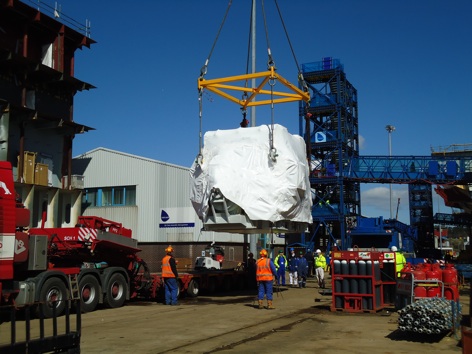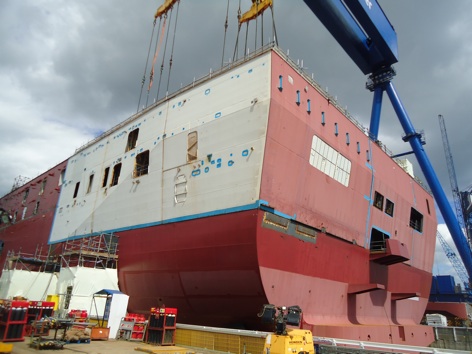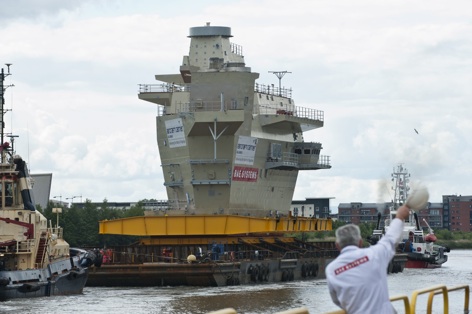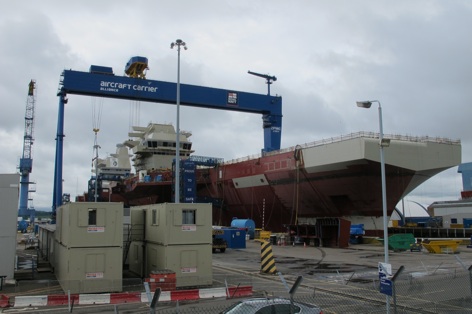Since my last blog in April work has continued, most visibly in the dry dock at Rosyth, but also at several other locations around the UK and indeed wider in the construction and increasingly the commissioning of the Nation’s Flagships Queen Elizabeth and Prince of Wales.
The aft Rolls Royce MT30 Gas Turbine Alternator (GTA) has been delivered to Rosyth, installed onto the pre-prepared seats in the starboard sponson of HMS Queen Elizabeth and then enclosed by the structural units that complete the sponson to flight deck level.

This evolution built on the experience gained from installation of the forward GTA and was accomplished within the programmed dates. The Centre Blocks CB05 and CB06 have also been installed at the aft end and thus completed the full length of the flight deck and totally enclosed the hangar. When standing at the aft end of the flight deck and looking forward the size of these huge ships becomes very clear.
Sponson units have been systematically lifted into position and installed on either side of the ship and, most recently, the huge aft island was lifted into place. Now the only significant structural units remaining to be installed are the extreme aft corners of the flight deck Sponsons SP11 and SP12.
Since it was shipped in March this year a lot of work has been done on the forward island to structurally consolidate it to the sponson structure below, to connect the gas turbine and diesel uptake and downtake trunking and to progress the system installation across the boundary. The island is at an advanced stage of outfit with the majority of the Mission System and other equipment already installed. The protective coverings on three of the windows in the observation bridge, one deck below the main bridge, have been replaced with perspex sheets so that the view forward and across the flight deck to port can be seen.

The design of the forward island and the open bridge wings and platforms provide a surprisingly good all round view considering the constraints of an aircraft carrier geometry. The view forward and to starboard is excellent with the bow of the ship being incongruously apparently a long way away to port.
There cannot be many ships where it is possible to see the bulbous bow from the bridge even when in dry dock. The view aft to the aircraft lifts is also excellent and across the wide expanse of flight deck.
Whereas the forward island is predominantly about navigating the ship, the aft island is all about flying control. The aft island has been built at BAE Systems yard at Scotstoun on the Clyde and in June was loaded out onto a barge and transported to Rosyth arriving under the iconic Forth Bridge on 21st June and shortly afterwards brought ashore. It was lifted into place on July 1, with a brief ceremony marking the occasion. Like the forward island, which was built at Portsmouth, the aft island is at a very high state of completion and on structural consolidation the Flyco compartment, which has been built as a module by TEX ATC ltd will be installed onto the seats on the port side of the island. This Flyco structure is arranged over two deck levels and includes huge windows giving unrivalled views across the flight deck and up the glide path where incoming aircraft will be approaching. It contains banks of consoles from which the Flying Control Officer and Landing Safety Officer will operate. The ergonomics of this compartment are vital to the efficient flying operations of the aircraft carrier and during the design phase a wooden full scale mock-up of the Flyco was manufactured at Portsmouth and used to carry out simulated operations to prove the design.

Like the forward island the lift of the aft island is a complex operation requiring an extensive lifting frame on which the island sits and a number of spreader bars to ensure that the rigging is kept clear of the overhanging structures and sponsons on the island. Installation of the aft island was another huge milestone in the development of the Queen Elizabeth Class aircraft carriers.
Under the stern of the ship the rudders are being fitted onto the rudder stocks as part of the preparations for installation of the propeller shafts. Alignment of the internal and external shaft bearings with the intended propeller location, the shaft seal location and the propulsion motor and thrust block seats requires a high degree of precision. Some adjustment through chocking and shimming of seats and machining of bearings is possible but the tolerances are quite tight. To as accurately as practicably simulate the shape that the ship will take up when afloat it is necessary to remove all the supports aft of the propeller locations before setting an initial line of sight along the shaft line to which the main outboard A brackets will be aligned and welded. This operation known as “dropping the stern” will occur as soon as the aft island welding has been completed and should happen over the summer months. It is the next significant milestone that the project is driving to in the preparation for flooding the dock and floating the ship out next year.

Inside Queen Elizabeth the first mole has been installed, but don’t worry this is not going to cause mole hills on the flight deck! These moles are a fundamental part of the Highly Mechanised Weapon Handling System, they are the trolleys that “burrow” into the magazine compartments, under remote control selecting the required weapon pallets and bringing them via the weapon lifts and the installed tracks to the weapon preparation areas and then ultimately up to the flight deck for loading onto the aircraft. Installation of this first mole indicates the level of completion that has been achieved in the magazines and air weapon preparation areas and is a major achievement for the team involved.
The development of the ships continues, the last of the Air Filtration Compartments has been awarded Compartment Plan Approval such that all three thousand plus compartments have now been formally approved and the first of the Compartment Completion Inspections (CCI) on board the ship have been successfully completed. With the number of compartments making up a Queen Elizabeth Class carrier these CCIs are now going to be coming up thick and fast.


Red Bull makes hydrogen fuel cell play with AVL
Formula 1 is an anachronistic anomaly where its only cutting edge is in engine development. The rules prohibit any real innovation and there would be...